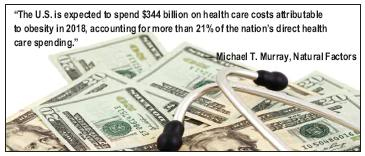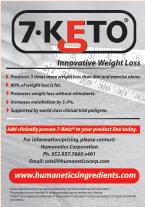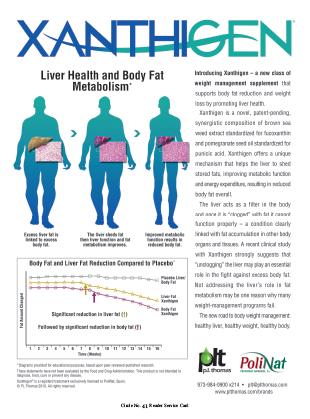The World Health Organization estimates one billion adults are overweight and 300 million are obese—devastating numbers—leading the organization to coin the term “globesity” (1). These are frightening figures considering the numerous health risks associated with being overweight. And, unfortunately, a very large portion of these people live in the United States, a land ruled by convenience and conflicting media portrayals of health issues.
 Jordan Rubin, CEO and founder of Garden of Life, West Palm Beach, FL, estimates that 72 million Americans are on a diet at any given time. Considering the obesity epidemic, simply “dieting” may not be the correct solution, but, rather, drastic shifts in thinking and lifestyle habits.
Jordan Rubin, CEO and founder of Garden of Life, West Palm Beach, FL, estimates that 72 million Americans are on a diet at any given time. Considering the obesity epidemic, simply “dieting” may not be the correct solution, but, rather, drastic shifts in thinking and lifestyle habits.
“If there is a silver lining, it is the fact that more attention is now being given to the connection between obesity and poor health and many in the food and beverage industry have started to take notice and develop well-formulated, healthy alternatives that fit into a healthy lifestyle regimen,” says Paul Dijkstra, CEO of InterHeath Nutraceuticals, Benicia, CA.
The natural products industry is poised to offer America the support, compassion, education—and maybe the little bit of tough love—it needs to become a healthy nation.
The Economics of Obesity
A startling argument circulating through the nation is that losing weight or even maintaining a healthy weight is too expensive, thus resulting in scores of overweight Americans. This thinking is unsound, as the effects of being overweight (economically, emotionally and physically) are far more costly.
Scott Steil, president of Nutra Bridge, Shoreview, MN, says, “Something is expensive when it does not provide value. Losing weight provides solid value to both quality of life and overall health.”
Economics do, however, have a lot to do with the issue of weight in America. Says Steil, “As consumers, we currently do not feel the economic pain of being overweight. Our insurance simply covers the costs associated with being obese and no monetary rewards really exist for those who work at losing weight and staying fit. This needs to change and will do so in the near future (as the burden of healthcare costs shifts to consumers).”
The price of keeping yourself healthy with good food, supplements and the outdoors (FREE!) is relatively small compared to the devastating costs of being overweight.
 Dollar menu dilemmas. Before we get to some shocking economic statistics about overweight and obesity, let’s take a look at the everyday dollars that are contributing to the obesity epidemic.
Dollar menu dilemmas. Before we get to some shocking economic statistics about overweight and obesity, let’s take a look at the everyday dollars that are contributing to the obesity epidemic.
Some have asked, can the recession make you fat? When poor health education is added to the equation, the answer would certainly be yes. Many people, when trying to save money, will cut back on healthful items such as fresh fish, fruit, vegetables and whole grains in favor of cheaper, bulk, processed options high in sugar and saturated fats.
There also seems to be the misconception that fast food or restaurant items are less expensive than foods in the grocery store. Truthfully, a five-dollar “value” meal, which is eaten in one sitting, is far pricier than five dollars spent on fresh foods items that could be used for more than one meal. Plus, being overweight tends to result in a cycle of eating more food in general, which brings the cost back up to what it would have been to buy more healthful options in the first place.
Retailers can help shatter value menu myths by offering community literature or seminars that make the budgets of healthy versus unhealthy eating easy to understand. Put together easy weekly shopping lists/recipes for customers and compare them to the costs of eating out for a week. You just might see your grocery sales boost because of it!
Ulrik Breval-Carlsson, president of Sprunk-Jansen, LLC, Petaluma, CA, says, “Making the decision to eat mostly from Mother Nature’s pantry, so to speak, does not need to cost so much.” Fresh produce and many organic/natural foods are often the same price as conventional foods or may be only slightly more expensive, and with much more valuable nutrition. Breval-Carlsson says, “The payoff is feeling much better!”
|
Select Weight Management Products
ALL ONE/Nutritech: Country Life Vitamins: Enzymatic Therapy, Inc.: Garden of Life: Health Plus, Inc.: Himalaya Herbal Healthcare: Interhealth USA: Jarrow Formulas: Lonza: Natural Factors: Nutra Bridge (Humanetics/innoVactiv): Nutratech, Inc.: PharmaChem Laboratories: Rainbow Light Nutritional Systems: ReserveAge Organics: Sprunk-Jansen, LLC: |
Marci Clow, M.S., R.D., senior director of product development for Rainbow Light Nutritional Systems, Santa Cruz, CA, recommends buying produce that is in season, which is usually less expensive than those shipped from far away, and also adding dry beans and whole grains as a healthy and inexpensive way to round out a diet.
Offering a more positive perspective on the recession–food predicament is Grace Ormstein, M.D., CTN, Ph.D., medical director and scientific advisor for Himalaya Herbal Healthcare, Houston, TX: “Financial challenges do encourage people to look for foods with ‘added value.’ There’s an emerging trend among consumers looking for ways to budget calories and dollars. A slower economy always encourages people to look for better quality nutrition on a smaller budget.”
Not so healthy statistics. While shelling out the cash to pay for a gym membership or organic produce may seem expensive, the true costs of not doing so are quite alarming. According to a study of national costs attributed to overweight (BMI 25–29.9) and obesity (BMI over 30), medical expenses accounted for 9.1% of total U.S. medical expenditures in 1998 and may have reached as high as $78.5 billion ($92.6 billion in 2002 dollars) (2).
Both direct and indirect healthcare costs have increased in the United States in relation to the prevalence of overweight and obesity, says Gene Bruno, M.S., MHS, a consultant for Los Angeles, CA-based Jarrow Formulas and Dean of Academics at Huntington College of Health Sciences. Direct healthcare costs refer to preventive, diagnostic and treatment services such as physician visits, medications and hospital and nursing home care. Indirect costs are the value of wages lost by people unable to work because of illness or disability, as well as the value of future earnings lost by premature death.
The Weight-control Information Network (WIN) offers the following statistics (3). Bruno notes that since WIN based these numbers on older statistics, the costs today are even higher than the figures given here.
- Total cost of overweight and obesity: $117 billion
- Direct cost of overweight and obesity: $61 billion
- Indirect cost of overweight and obesity: $56 billion
- Cost of lost productivity related to overweight and obesity among Americans ages 17 to 64: $3.9 billion
The following are annual numbers:
- Workdays lost: $39.3 million
- Physician office visits: $62.7 million
- Restricted-activity days: $239 million
- Bed-days: $89.5 million
Granted, personal trainers, gyms and diet programs can sometimes be very expensive, but in reality, they are not needed. Sunil Kohli, C.E.O. of Health Plus, Inc., Chino, CA, says, “They simply need to be sensible and follow a healthy diet along with proper supplementation. Look at it this way: getting in shape, both inner and outer, goes a long way in helping to lower future bills for surgery, hospital stays and an expensive cocktail of pharmaceuticals.”
And, preventing obesity through proper health education is far more cost-effective than trying to repair the damage of an obese society.
The future is precarious, says Michael T. Murray, N.D., director of product development and education for Natural Factors Nutritional Products, Inc., Everett, WA, who foresees rising obesity numbers to create an “economic catastrophe.” He provides the following numbers:
- If current trends continue, 103 million Americans will be considered obese by 2018.
- The United States is expected to spend $344 billion on healthcare costs attributable to obesity in 2018, accounting for more than 21% of the nation’s direct healthcare spending in 2018.
- If obesity levels hold at their current rates, the United States could save an estimated $820 per adult in healthcare costs by 2018—a savings of almost $200 billion.
But, asks Murray, how much would the savings be if we actually reversed the trend? Considering that the risk of diabetes, cardiovascular disease, high cholesterol, arthritis, depression, cancer, liver disease, gallbladder disease and others increases as weight does, it would be priceless, to say the least.
Weighing in on Supplements
Supplements can be viewed as an investment in long-term health. But weight-management supplements, in particular, have seen their fair share of controversy, especially concerning regulation. Recently, a federal district court ruled that a company needed to pay $2 million to the Federal Trade Commission for making misleading weight-loss claims, as part of its “Big Fat Lie” crackdown on weight-loss claims. “This sets an important precedent and increases the stakes for those who continue to make weight-loss claims and engage in hyperbole without scientific substantiation,” says Bob Green, president at Nutratech, Inc., West Caldwell, NJ.
Regulatory actions such as these support reputable companies and are encouragement for those companies to create even higher quality products.
Although the natural products industry has some amazing products, experts agree that there is no “magic bullet” or pill that can induce healthy weight loss effectively, but there are some supplements that can certainly be helpful when pursuing the proper way to lose weight. “A pill alone cannot be promoted as a safe way to manage weight; diet and exercise must be part of the regimen,” says Clow.
After assessing an individual’s needs and their approach to weight management, retailers can recommend several varieties of supplements that may help. Kohli says, “Many people need professional guidance. Health food stores can work closely with nutritionists and naturopaths as well as fitness trainers to get people started on the right path to health. Expert guidance and encouragement can go a long way to successful weight loss.”
Satiety/suppressants. Reducing the feeling of hunger and increasing satiety are well-known methods to help with weight loss. New research is hitting the market that addresses ingredients used to create a feeling of fullness. According to Koos Osterhaven, manager at Nizo Food Research, based in the Netherlands, specific aromas and texture ingredients are being utilized to create the “perception of being full”(4). For example, a crunch factor or a certain aroma or flavor will trigger the “I’ve had enough” reflex in the brain. This flavor-induced satiation can help people think they are getting more fat or sugar than they really are, leading to reduced calorie intake.
Traditionally, one of the most common satiety weight-loss aids is fiber, which also helps with colon and digestive regularity. According to Murray, “Some diets recommend 35 grams or more of fiber per day to promote weight loss; the reality is that 75–100 grams or more of fiber per day would be required in order to have highly significant effects in producing weight loss in overweight individuals.” Most Americans only consumer five to 15 grams of fiber per day, he says. Adding approximately 60 more grams of dietary fiber is impractical for most Americans from a food point of view. Therefore, supplementation can be extremely beneficial.
Kohli touts a natural fiber, psyllium for promoting colon regularity, as well as supporting the health of the structure and function of the lower digestive system. Soluble fiber reacts by absorbing water in the intestine, creating a gel substance, which can create a full feeling.
Jason Mitchell, vice president of research and product development and education for County Life Vitamins, Hauppauge, NY, notes that the two meals usually requiring some help in controlling caloric intake are breakfast and dinner and recommends taking a satiety supplement before these meals. He recommends a liquid fiber supplement (Liquid Fiber X from Country Life), which offers 57% of the daily-recommended amount of fiber in one serving.
Another common satiating compound is Garcinia cambogia, or hydroxy citric acid (HCA). According to Dijkstra, a randomized, placebo-controlled study utilizing a patented hyroxy-citric acid product (Super CitriMax from InterHealth) significantly decreased daily energy [caloric] intake by 25% and calories from snacking by 40% compared to a placebo, leading to reduced body weight.
Fructooligosaccharides (FOS) are plant fibers found in fruits, vegetables and cereals, says Bruno, which are used as probiotics to support beneficial intestinal bacteria to promote healthy digestion.
Other herbal supplements, such as hoodia and Cha’ de bugre, have also traditionally been used as appetite suppressants.
Thermogenics. Thermogenesis is the process that produces heat, or energy, in the body to increase resting metabolic rate and the rate at which fat is released from body stores and broken down (lipolysis) to help burn fat and calories. Physical activity activates thermogenesis, as does exposure to cold or eating a meal.
There are also supplements that can enhance thermogenesis. Citrus aurantium, or bitter orange, is one of these. A patented bitter orange extract (Advantra Z from Nutratech) has been found to stimulate thermogenesis, reducing weight, increasing the percentage of lean muscle in relation to total body mass, improving athletic performance and suppressing the appetite, says Green.
 DHEA (for example, the branded 7-Keto from Humanetics) is another thermogenic. Steil says, “7-Keto is naturally found in our bodies, but declines dramatically with age. Typically, a person loses about 50% of their endogenous 7-Keto levels by age 40. This results in our bodies’ inability to burn fat like it used to when we were younger.” Supplementation can help restore these levels and get metabolism burning.
DHEA (for example, the branded 7-Keto from Humanetics) is another thermogenic. Steil says, “7-Keto is naturally found in our bodies, but declines dramatically with age. Typically, a person loses about 50% of their endogenous 7-Keto levels by age 40. This results in our bodies’ inability to burn fat like it used to when we were younger.” Supplementation can help restore these levels and get metabolism burning.
Green tea (Camellia sinensis) has long been thought to aid weight loss because of its active catechins and caffeine. Bruno says, “Research has demonstrated that green tea is capable of stimulating thermogenesis and promoting fat oxidation; in other words, it helps burn body fat.” It can work by drinking cups of the tea, or taking supplements that contain green tea’s active components.
Other herbal thermogenics are ginger and fucoxanthin.
Fat binders/liptropics. Fat binders work by linking to dietary fats and thus preventing their digestion and absorption by the body. Chitosan, derived from the fibers called chitin naturally present in shellfish, has been called a “fat attractor,” with the ability to “soak up fat.” The use of fat binders is not recommended for long-term use, as they can impede the absorption of fat-soluble vitamins (A, D, E and K) and essential fatty acids. Some reports of unpleasant side effects have also been reported.
Methionine, choline, inositol and betaine are examples of lipotropics, which play an important role in metabolizing fat and can prevent the build up of excess fat in the liver. Lipotropics increase the liver’s production of lecithin, which breaks up cholesterol and moves it through the bloodstream without clogging the arteries. Methionine and choline are also responsible for detoxifying the metabolic waste generated by the breakdown of proteins in the body.
Another approach may be to use conjugated linoleic acid (CLA), a free fatty acid that may help the body reduce fat deposits by promoting apoptosis in fat cells (5). In a double-blind, 12-week study, CLA supplementation was shown to promote a decrease in body fat: 53 men and women supplemented with 4,200 mg CLA daily or a placebo with a decrease in body fat of 3.8% in the CLA group (6). According to Bruno, other studies “showed that CLA supplementation for 24 months in overweight adults was well tolerated and also confirmed that CLA decreases body fat mass, and may help maintain initial reductions in body fat mass and weight in the long term.”
Amino acids. Amino acids have a profound effect on most cellular body functions, and therefore are key to maintaining a healthy weight.
 5-HTP, an amino acid that is converted to serotonin in the body, may also help with weight control. Low levels of serotonin have been linked with low mood, which has been associated cravings, especially carbs, and lack of motivation to engage in physical activity.
5-HTP, an amino acid that is converted to serotonin in the body, may also help with weight control. Low levels of serotonin have been linked with low mood, which has been associated cravings, especially carbs, and lack of motivation to engage in physical activity.
A study (7) involving 25 overweight non-insulin-dependent diabetic outpatients were enrolled in a double-blind, placebo-controlled study, and randomized to receive either 5-HTP (750 mg/day) or a placebo for two consecutive weeks, during which no dietary restriction was prescribed. While the placebo group saw no significant reduction in daily calorie intake, patients receiving 5-HTP significantly reduced their daily calorie intake by 21% (from 1933 to 1527 calories) over a period of two weeks and also lost five pounds. This calorie reduction was the result of a decreased intake of carbohydrates and fats, says Bruno.
L-carnitine is another example of an amino acid that can aid in weight loss. Fatty acid breakdown (ß-oxidation) and subsequent energy production occur inside the mitochondria of the human cell. The mitochondrion are frequently referred to as the “furnaces” of the cell, since they are where energy is produced. In order to produce energy from fat, long chain fatty acids need to move into the mitochondrion. However, the mitochondrial membrane acts as a barrier to long chain fatty acids, refusing permission to enter.
This is where L-carnitine comes into play, says Kevin Owen, Ph.D., NAFTA head of technical marketing and scientific affairs for Lonza, Allendale, NJ. L-carnitine binds to the long-chain fatty acids and “shuttles” the fatty acids into the mitochondria where they can be subsequently be broken down and energy can be produced in the form of adenosine triphosphate (ATP).
Because the amount of dietary L-carnitine may decrease when dieting, supplementation is a great option. A placebo-controlled study with obese adolescents showed that L-carnitine supplementation (2 g per day for 12 weeks) promoted significant weight loss, a decrease in BMI and body fat content when used as a component of an overall weight-management program (8). It is important to note that vitamin B12 is necessary for carnitine metabolism (9).
Other amino acids that may be helpful for weight loss are L-tryptophan and L-tyrosine.
 Blood Sugar: Slow versus Low
Blood Sugar: Slow versus Low
Blood sugar stability is key to healthy weight management. Spikes and falls in blood sugar can lead to low energy, moodiness and cravings. Weight-loss programs have gone through a myriad of trends and fads, most including a prefix of “low.” Today, we are learning that slow may be better than low.
A study referenced by Bruno (10) indicating that a weight-loss diet focusing on low-glycemic index foods (foods where carbohydrates are slowly introduced to the blood) was found to be more effective than traditional low-carb, low-fat or low-calorie diets in losing weight and promoting heart health. In the study, 11 obese young adults did not avoid carbs or fats, nor did they count calories or eat prepackaged foods. Despite this, these slow-carb dieters lost more weight than 12 of their peers on a conventional low-fat diet. Specifically, after 12 months on the diets, the slow-carb group lost 7.8% of their body weight (16 lbs) compared with 6.1% (11 lbs) in the low-fat group.
Research has even shown that consuming as little as one low-glycemic meal daily (breakfast) can help reduce appetite and promote weight loss (11).
Fiber is important for blood sugar stability. According to Mitchell, fiber is a “stop gate” for sugar spilling into the bloodstream that causes a spike in insulin. Fiber slows stomach emptying and prevents the rapid digestion and absorption of carbohydrates. A patented fiber supplement (PGX from Natural Factors) has been clinically shown to stabilize blood sugar, increase insulin sensitivity and reduce the glycemic index of any food or meal by 35–50%, says Murray.
Chromium may also help with blood sugar stability by supporting normal insulin function, says Dijkstra. “Normal insulin function is critical since it supports balanced blood sugar levels, which, in turn, may help with appetite control and reduced food cravings, especially for sweets and fatty foods,” he says. According to Dijkstra, randomized, double-blind, placebo-controlled research shows that a patented chromium supplement (ChromeMate) can increase fat loss and lean body mass.
Cinnamon is an example of an herbal remedy for blood sugar stability, as well as gymnema sylvestre.
In Our Wiring
Sometimes, our weight can be affected by conditions inherent to our body chemistry. Alyssa Peterson, associate marketing manager for Enzymatic Therapy, Inc., Green Bay, WI, says, “There are many medical and genetic factors that affect weight, it is not always as simple as personal responsibility.” Thyroid health is one of these, as this gland produces hormones that regulate metabolism. A condition called hypothyroidism is often associated with weight gain because of the resulting decrease in certain hormones.
Luckily, there are supplements that can help regulate thyroid function. For example, L-tyrosine is an amino acid needed by the thyroid to produce one of the most important metabolism-controlling hormones. Iodine is also crucial for this.
According to materials referenced by Bruno, 7-Keto is a metabolite of DHEA that also is thought to benefit weight loss by increasing metabolism and thermogenesis by promoting healthy levels of the thyroid hormone triiodothyronine (T3) (12). Guggul has also been thought to stimulate thyroid hormone production, and therefore metabolic rate, particularly one compound, guggulsterone.
Other health factors can also have an effect on weight management, some of which may be addressed through supplementation. According to James Perin, scientific advisor for ReserveAge Organics, Gainesville, FL, “Resveratrol has been proven in studies to activate the SIRT1 ‘longevity gene,’ enhance energy and endurance and provide substantial antioxidant protection.”
Human studies with resveratrol have been limited, but a 2004 small animal study showed that resveratrol could significantly decrease insulin secretion and delay the onset of insulin resistance (13).
Another study, published in 2009, postulates that resveratrol may modulate mitochondrial function to “improve resistance to a modern lifestyle,” meaning certain characteristic of metabolic syndrome (14).
Detoxing Detox Myths
Traditionally, detoxification is meant to remove toxins from the body, but in America today, its meaning has become somewhat skewed and exaggerated. Detoxification is not synonymous with weight loss, as many would believe, although weight loss is often experienced at the same time because of the body beginning to function more optimally.
One thing is for sure: “extreme” detox diets such as fasting are “the worst thing you can do to your body,” says Steve Holtby, president and CEO of Soft Gel Technologies, Inc., Los Angeles, CA. “When you deprive your body of food, it goes into starvation mode—your metabolism slows down in an effort to conserve resources. When you begin eating normally again after a period of fasting, your body continues to idle at a lower rate and you don’t burn calories as quickly.”
Most of the weight lost during fasting is water and muscle mass, not fat. Bruno confirms, “The risks of some so-called detox diets are that they are generally not particularly healthy diets (i.e., do not provide good nutrition), and they can give you a false sense of weight loss while all you are really experiencing is a profound laxative effect,” says Bruno.
Common sense (and checking with a healthcare provider) is key when it comes to detoxification. If a program advises that caloric intake be dropped down to 100 calories a day with a splash of lemon juice and cayenne pepper on the side, it’s not healthy and, frankly, doesn’t make sense.
 However, says Ormstein, “Hectic lifestyles and unknowing exposure to millions of toxic molecules—all of them accumulated in our fat tissue every day—promote even more weight gain.” For this reason, a detoxification program can be beneficial as one aspect of healthy weight loss. Ormstein continues, “When the human body is polluted, normal function is affected in a way that can lead to serious malfunction. Our bodies have naturally built-in eliminators, but their systems are slowed down by accumulated pollution. A detox diet in conjunction with gentle, herbal supplements can bring back the effectiveness of the elimination process.” This can promote a return to normal metabolism function.
However, says Ormstein, “Hectic lifestyles and unknowing exposure to millions of toxic molecules—all of them accumulated in our fat tissue every day—promote even more weight gain.” For this reason, a detoxification program can be beneficial as one aspect of healthy weight loss. Ormstein continues, “When the human body is polluted, normal function is affected in a way that can lead to serious malfunction. Our bodies have naturally built-in eliminators, but their systems are slowed down by accumulated pollution. A detox diet in conjunction with gentle, herbal supplements can bring back the effectiveness of the elimination process.” This can promote a return to normal metabolism function.
Peterson agrees, “Detoxification is beneficial in our toxic world. Toxins are in the air, food and water; you just can’t avoid them. Cleansing can help jumpstart a diet and exercise program and support weight loss and body energy.”
The Reality of “Reality”
The age of electronic media and reality television has left the American public highly susceptible to emotional and physical damage associated with unreal expectations of body image and weight. And although supplements can be helpful, retailers will be useless in handling customers with weight concerns, unless they understand some of the factors contributing to Americans’ decisions about weight and health, as well as the societal effects surrounding body issues.
While the numbers certainly say a lot about the state of Americans’ health, “the true cost of being overweight is astounding,” says Steil. “It is tough to put a numeric value to the quality of life that obesity impacts. These include self esteem, the ability to perform everyday tasks, changing wardrobes, relationships, professional advancement and one’s sex life.”
 Media. People have always looked to the media, film, magazines and television to mimic how their bodies “should” look, what we should eat and how we should work out. But, says Julie Tomlinson, sales and marketing manager for All One/Nutritech, Santa Barbara, CA, “Conflicting information from the media really does the public a disservice, confusing them.” One reality “doctor show” will expound the virtues of curvier hips, while another talk show host or author will say that liposuction isn’t really a bad way to go at all.
Media. People have always looked to the media, film, magazines and television to mimic how their bodies “should” look, what we should eat and how we should work out. But, says Julie Tomlinson, sales and marketing manager for All One/Nutritech, Santa Barbara, CA, “Conflicting information from the media really does the public a disservice, confusing them.” One reality “doctor show” will expound the virtues of curvier hips, while another talk show host or author will say that liposuction isn’t really a bad way to go at all.
Breval-Carlsson says, “Health status is the absolute priority. Women—and men—come in different body types: ectomorph, endomorph and mesomorph, and there is nothing that can change one to the other. Women [and men] must accept their natural shape, and work to make it the best it can be, while also keeping in mind that taking care of the insides, too, with proper nutrition and hydration is a gift of lasting benefit.”
 Americans receive mixed signals constantly. In addition, says Peterson, “Our society is all about time and convenience. We are also bombarded with advertising for foods that are high in fat, calories and sugar.”
Americans receive mixed signals constantly. In addition, says Peterson, “Our society is all about time and convenience. We are also bombarded with advertising for foods that are high in fat, calories and sugar.”
Mitchell adds that the government’s Food Pyramid is way off base, with extremely distorted proportions of the major food groups. Instead, he recommends everyone consume a daily diet of 50% vegetables, 25% fruit (earlier in the day because of the sugar content) and a remaining 25% of meats, dairy and grains. Eating in moderation is key, he emphasizes.
Parents also need to understand that proper nutrition habits begin for a child in the womb, when their body chemistries are being formed. Adding to this, Ormstein says, “Children who are raised in families where poor food selection and large quantities are the norm usually continue those same eating habits for the rest of their lives.”
No butts about it. Another reality that America must face is that thin doesn’t always equal healthy. Now, this doesn’t mean just the forced body types of models; there is an entire weight category that hasn’t been paid enough attention: normal weight obesity.
Normal weight obesity is when the body is in its recommended weight range, but the percentage of body fat to that weight is so high as to be classified as obese. So, a woman who is 5 feet 5 inches tall, weighing 140 pounds, would have a normal BMI of 23.3. But, if 42 of those pounds are fat (30%) the woman would have normal weight obesity (15).
 Thus, there is no way to get around it. Simply being thin is no longer an excuse—exercise is essential for maintaining crucial muscle mass and keeping fat levels in control.
Thus, there is no way to get around it. Simply being thin is no longer an excuse—exercise is essential for maintaining crucial muscle mass and keeping fat levels in control.
Role “models.” So many elements factor into why or why not someone will be successful at managing their weight. Undoubtedly, change is scary and losing weight is difficult, but it is also such an important issue that many of the reasons for not achieving success become excuses.
For example some argue that they can’t “trust” Surgeon General Regina Benjamin’s message that Americans should lose weight because she herself is overweight. Truthfully, the surgeon general is a person like everyone else, who may have the same struggles as anyone else, but her message is still valid and her advice should be heeded. Instead, she is scapegoated as being an unworthy role model.
To this, Clow says, “People always want to point the finger at someone else, when really, the only person who can take control of your health is you.”
Instead of looking at an accomplished, educated woman like Surgeon General Benjamin, the public often looks to the wrong places for their role models. These are the models that are usually too thinly stretched across the pages of magazines. But lately, models have been growing in size, prompting a variety of responses. Although using larger models is an improvement from constantly advertising the skeletal, it still doesn’t seem to point the public in the right direction—toward being healthier, not mimicking an image in a magazine.
 Ormstein says, “I think there’s a trend in advertising to focus on extremes; either skinny, bony models with transparent, pale, unhealthy skin, or the other extreme; pictures of happy overweight and obese models. Seeing either extreme has a negative effect on people who are committed to losing weight. People need realistic support and encouragement to lose weight. They don’t need pictures of overweight or obese models who are seemingly happy and healthy. Distortions like that are counterproductive to developing and sticking to a successful weight-loss program.”
Ormstein says, “I think there’s a trend in advertising to focus on extremes; either skinny, bony models with transparent, pale, unhealthy skin, or the other extreme; pictures of happy overweight and obese models. Seeing either extreme has a negative effect on people who are committed to losing weight. People need realistic support and encouragement to lose weight. They don’t need pictures of overweight or obese models who are seemingly happy and healthy. Distortions like that are counterproductive to developing and sticking to a successful weight-loss program.”
Perin of ReserveAge agrees: “There has been great damage to the psyche of women and men. About 60% of women say they are unhappy with their looks and the men’s statistics are not far behind.”
These statistics imply that instead of losing weight for health reasons, people are more motivated by concern for their looks.
A recent near-nude photo of the model Lizzi Miller in Glamour rocked the world of modeling, as she unreservedly exposed her not so flat belly, a part of her body that received much attention (it’s a cute “pooch,” many said). Many extol her as woman of “normal” weight, not plus-sized as the modeling industry would categorize her, representing more of what American women are like. While she is undoubtedly beautiful and surely represents a healthier weight than many of her emaciated peers, the concern arises when unhealthy abdominal fat, which has been noted to the most dangerous kind, is called “cute.”
Promoting self-confidence is great, but it should also inspire the confidence to recognize what’s healthy, what’s not and make changes, rather promoting complacency and contentedness with the status quo. There’s a difference between saying, “I accept myself for who I am” and “I accept my unhealthy weight.”
In the end, body image may always be misrepresented; it’s up to us to reinforce healthy habits, healthy weight and self-image based on reality, not “reality.” WF
References
- World Health Organization, www.who.int/dietphysicalactivity/publications/facts/obesity/en/, accessed Feb. 5, 2010.
- EA. Finkelstein, et al., “National Medical Spending Attributable to Overweight and Obesity: How Much, and Who’s Paying?” Health Affairs Web Exclusive, 2003; W3:219-226, http://content.healthaffairs.org/cgi/content/full/hlthaff.w3.219v1/DC1.
- Statistics related to obesity and weight loss, WIN Weight control Information Network. May 2007, http://win.niddk.nih.gov/statistics/#econ, accessed January 14, 2010, accessed Feb. 5, 2010.
- IFT Food Expo video, Anaheim, CA, June 6–10, 2009, http://live.ift.org/video-gallery/#, accessed Feb. 3, 2010.
- J.L. Miner, et al., “Conjugated Linoleic Acid (CLA), Body Fat, and Apoptosis,” Obes. Res. 9 (2), 129–134 (2001).
- A. Smedman, et al., “Conjugated Linoleic Acid Supplementation in Humans—Metabolic Effects,” Lipids 36 (8), 773–781 (2001).
- C. Cangiano, et al., “Effects of Oral 5-Hydroxy-Tryptophan on Energy Intake and Macronutrient Selection in Non-Insulin Dependent Diabetic Patients,” Int. J. Obes. Relat. Metab. Disord. 22 (7), 648–654 (1998).
- Z. Sufeng, et al., Acta. Nutr. Sin. 19 (2), 146, 1997.
- R. Katz, The Official Anti Aging Revolution (Basic Health Publications, Laguna Beach, CA, 2007).
- C.B. Ebbeling, et al., “Effects of an Ad Libitum Low-GIycemic Load Diet on Cardiovascular Disease Risk Factors in Obese Young Adults,” Am. J. Clin. Nutr. 81 (5), 976–982 (2005).
- S. Pal, et al., “The Effect of a Low Glycaemic Index Breakfast on Blood Glucose, Insulin, Lipid Profiles, Blood Pressure, Body Weight, Body Composition and Satiety in Obese and Overweight Individuals: A Pilot Study,” J. Am. Coll. Nutr. 27 (3), 387–393 (2008).
- C.M. Colker, et al., “Double-Blind Study Evaluating the Effects of Exercise Plus 3-Acetyl-7-oxo-dehydroepiandrosterone on Body Composition and the Endocrine System in Overweight Adults,” J. Exercise. Physiol. Online 2 (4), abstract #30, (1999).
- H.C. Su, et al., “Resveratrol: A Red Wine Antioxidant, Possesses an Insulin-like Effect in Streptozotocin-indiced Diabetic Rats,” Am. J. Physiol. Endocrinol. Metab. 290 (6), E1339–46 (2006).
- A.V. Nunn, et al., “Endocannabinoids, FOXO and the Metabolic Syndrome: Redox, Function and Tipping Point-The View From Two Systems,” Immunobiology, Epub May 18, 2009.
- The Mayo Clinic, www.mayoclinic.com/health/normal-weight-obesity/AN02007, accessed Feb. 8, 2010. Cleanse Away 7-Day Renewal (AM Citrus Cleanse, Daily Fruit & Fiber and PM Purify).
Published in WholeFoods Magazine, March 2010










